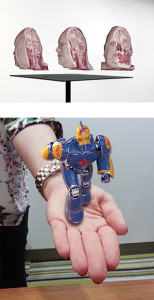Magic Leap A startup is betting more than half a billion dollars that it will dazzle you with its approach to creating 3-D imagery. Availability: 1-3 years
 Essentially, it has developed an itty-bitty projector that shines light into your eyes—light that blends in extremely well with the light you’re receiving from the real world.
Essentially, it has developed an itty-bitty projector that shines light into your eyes—light that blends in extremely well with the light you’re receiving from the real world.
By day, Abovitz is a technology entrepreneur with a background in biomedical engineering. He previously founded Mako Surgical, a company in Fort Lauderdale that makes a robotic arm equipped with haptic technology, which imparts a sense of touch so that orthopedic surgeons have the sensation of actually working on bones as they trigger the robot’s actions. Mako was sold to a medical technology company, Stryker, for nearly $1.7 billion in 2013. By night, Abovitz likes to rock out. He sings and plays guitar and bass in a pop-rock band called Sparkydog & Friends. And as he tells it, Magic Leap has its origins in both the robotic-surgery company and his life as a musician.
Combining virtual reality with the physical world appealed to Abovitz even at Mako. Although the robotic-arm technology could give surgeons the sensation of touching their instruments to bones, Abovitz also wanted to let them see virtual bones as they went about this work. Over and over, he says, he tried out head-mounted displays made by different companies, but he was disappointed with them all. “They were all just complete crap,” he says. “You’d put it on and it would give you a headache and it was awful, and I was wondering, ‘Why is this so bad?’”
The next morning, though, he awoke with an idea: why bother with the painstaking steps needed to send a hologram out into a room for multiple people to see at once? Why not, instead, essentially make a hologram that only you see, doing it in a way that is natural for the eyes and brain to perceive, unlike stereoscopic 3-D? “We’re spending half a billion dollars–plus to effectively make nothing happen to you, physiologically,” Abovitz says.
The solution he and Macnamara and the rest of Magic Leap’s team have come up with is still largely under wraps, and on the record they avoid discussing how the technology works except in vague terms, citing concerns about competition. But it’s safe to say Magic Leap has a tiny projector that shines light onto a transparent lens, which deflects the light onto the retina. That pattern of light blends in so well with the light you’re receiving from the real world that to your visual cortex, artificial objects are nearly indistinguishable from actual objects.
It’s clear that getting the technology into that small form will be very hard. The smallest demo hardware I’ve seen at Magic Leap can’t yet match the experience of the bigger demo units. It includes a projector, built into a black wire, that’s smaller than a grain of rice and channels light toward a single see-through lens. Peering through the lens, I spy a crude green version of the same four-armed monster that earlier seemed to stomp around on my palm. In addition to improving the resolution of smaller units, Magic Leap will have to cram in sensors and software that will track your eyes and fingers, so you can control and interact with its virtual creatures—which themselves will have to incorporate real-life objects into whatever they appear to be doing.
See the full story here: http://www.technologyreview.com/featuredstory/534971/magic-leap/
Pages
- About Philip Lelyveld
- Mark and Addie Lelyveld Biographies
- Presentations and articles
- Tufts Alumni Bio